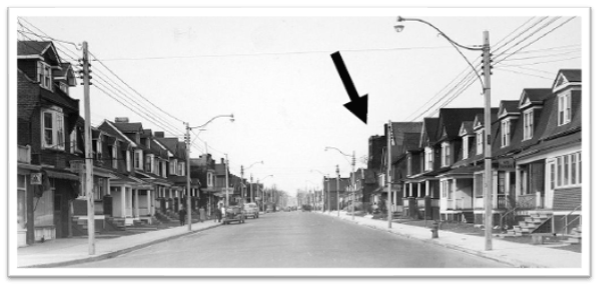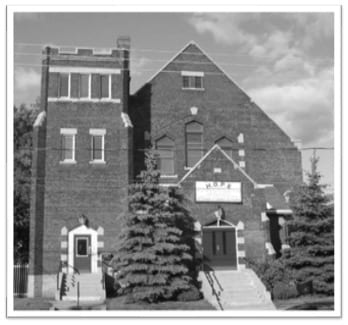Constructed in 1912 at a reported cost of $16,500, the Dufferin Street Presbyterian Church was listed on the City of Toronto Inventory of Heritage Properties in 2005. In 2015, Toronto and East York Community Council enacted a by-law to designate the property as being of cultural heritage value.
Dufferin Street Presbyterian Church is valued as an example of an early 20th century institutional building with medieval-inspired detailing, including arched openings and buttresses. The Neo-Gothic styling was popular for educational and ecclesiastical buildings during the World War I era.
A local landmark, notable for its prominent corner tower and chimney, Dufferin Street Presbyterian Church is located at the west end of Dovercourt, the formerly unincorporated community that developed around Dovercourt Park, prior to its annexation by the City of Toronto in 1910.
With the rapid growth of the Dovercourt, the wood frame church that was erected on the site in 1908 to serve a Presbyterian congregation, required replacement with a larger facility. Dufferin Street Presbyterian Church was commissioned in 1911 and dedicated the following year.


William Rufus Gregg, the architect of Dufferin Street Presbyterian Church, was born in Belleville in 1852, the son of a well-known Presbyterian minister. The family’s connection with the Presbyterian church was instrumental in Gregg’s career as an architect as he went on to design 20 churches for Presbyterian congregations across Ontario and Manitoba.
Gregg’s career commenced in 1872 when he articled for the Toronto office of Smith & Gemmell, after which time he worked in Montreal, Chicago and Boston before returning to Toronto in 1882, opening an office under his own name. Gregg practiced as both a sole practitioner and in collaboration with his brother.
The construction of the church at 1183 Dufferin Street followed Gregg’s earlier commission for Dovercourt Road Presbyterian Church, at 700 Dovercourt Road, which is also a recognized heritage property.
During Gregg’s lengthy career, he produced a variety of industrial, institutional and residential, buildings including the Women’s Medical College in Cabbagetown (1889) and the Canadian Order of Foresters’ Hall on College Street (1910).
Gregg passed away in October 1930 at his residence, Wiecroft Farm, in Oakville.
